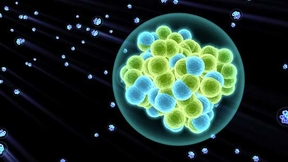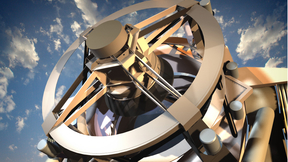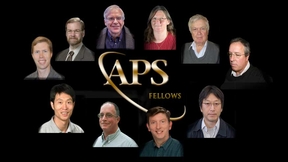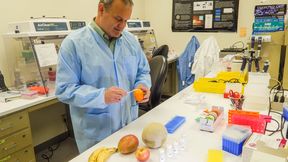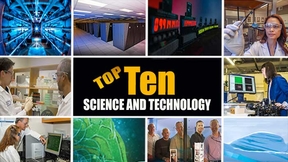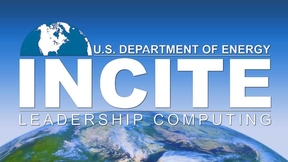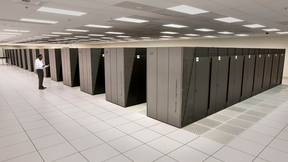Back
Science
LLNL's 2015 Year-in-Review
Lawrence Livermore's month-by-month highlights from 2015 are available online in the 2015 Year-in-Review edition of Newsline. As in the past, listings are in four categories: Science and Technology; People; Operations; and Awards and Recognition. The 2015 Year-in-Review will appear only electronically; there will be no print edition. The Web-based format offers the…
Lawrence Livermore credited with discovery of elements 115, 117 and 118
The International Union of Pure and Applied Chemistry (IUPAC) has confirmed that Lawrence Livermore National Laboratory scientists and international collaborators have officially discovered elements 115, 117 and 118.The announcement means those three elements are one step closer to being named.Lawrence Livermore teamed with the Joint Institute for Nuclear Research in Dubna…
New results from experimental facility deepen understanding of dark matter
LEAD, S.D. – The Large Underground Xenon (LUX) dark matter experiment, which operates nearly a mile underground at the Sanford Underground Research Facility (SURF) in the Black Hills of South Dakota, has already proven itself to be the most sensitive dark matter detector in the world. Now, a new set of calibration techniques employed by LUX scientists has further improved…
LLNL wins three 2014 R&D 100 awards
Lawrence Livermore National Laboratory researchers are the recipients of three awards among the top 100 industrial inventions worldwide for 2014. The trade journal R&D Magazine announced the winners of its annual awards, sometimes called the "Oscars of invention," Friday in Las Vegas. With this year's results, the Laboratory has now captured a total of 155 R&D…
Researchers put pressure on hydrogen
A National Ignition Facility (NIF) experimental campaign may have unlocked scientific secrets behind how hydrogen becomes metallic at high pressure."Hydrogen properties are still puzzling," said Lawrence Livermore National Laboratory (LLNL) physicist Marius Millot. "In particular, back in 1935, it was predicted that hydrogen should become metallic at sufficiently high…
Construction to begin on world's largest camera
The Department of Energy has approved the start of construction for a 3.2-gigapixel digital camera — the world’s largest — for the Large Synoptic Survey Telescope (LSST).The construction milestone, known as Critical Decision 3, is the last major approval decision before the acceptance of the finished camera. Construction of the telescope was previously approved by the…
Nanocrystals don't add up for reactor materials
Lawrence Livermore researchers have found that nanocrystalline materials do not necessarily resist radiation effects in nuclear reactors better than currently used materials.As researchers hunt for materials with the ability to withstand prolonged radiation damage, the use of nanostructured materials, with high interfacial area to absorb radiation-induced defects, has been…
Comatose galaxies shocked back to life
Galaxies are often found in clusters, which contain many "red and dead" members that stopped forming stars in the distant past. Now an international team of astronomers, including Will Dawson of Lawrence Livermore National Laboratory, has discovered that these comatose galaxies can sometimes come back to life. If clusters of galaxies merge, a huge shock wave can drive the…
LLNL finds a place in the sun
This year marks five years in space for NASA's Solar Dynamics Observatory (SDO), which provides incredibly detailed images of the whole sun 24 hours a day.Capturing an image with one arcsecond spatial resolution at 10 different wavelengths once per 10 seconds, SDO has provided an unprecedentedly clear picture of how massive explosions on the sun grow and erupt ever since…
White House Science & Technology policy associate director to join Lawrence Livermore
LIVERMORE, California — Patricia Falcone, the associate director for National Security and International Affairs in the White House Office of Science and Technology Policy (OSTP), has been selected as deputy director for Science and Technology at Lawrence Livermore National Laboratory (LLNL).Falcone will join the Lab on April 7."Falcone’s proven leadership and expertise in…
Ten Lawrence Livermore National Laboratory researchers named 2014 APS fellows
LIVERMORE, Calif. – Ten Lawrence Livermore National Laboratory (LLNL) scientists have been selected as 2014 fellows of the American Physical Society (APS).The new fellows represent a wide selection of physics expertise, ranging from laser science to hohlraum design to theoretical solid state physics. APS fellowships are awarded after extensive review and are considered a…
Lawrence Livermore highlights from 2014
Newsline's month-by-month highlights from 2014 are available on the Web. As in the past, listings are in four categories: Science and Technology; People; Operations; and Recognition and Awards. The 2014 Year-in-Review will appear electronically; there will be no print edition. The Web-based format offers the advantage of providing links to the referenced Newsline articles,…
Technology quickly traces source of tainted food
LIVERMORE, California – Foodborne illnesses kill roughly 3,000 Americans each year and about 1 in 6 are sickened, according to the Centers for Disease Control and Prevention. Yet most contaminated foods are never traced back to their source. That’s because existing methods to track tainted food following its supply chain from table to farm are highly inefficient,…
Top 10 science and technology stories of 2014
In 2014, Lawrence Livermore National Laboratory (LLNL) built on a 62-year tradition of translating basic science into technologies that ensure national security, address pressing real world problems and expand the boundaries of fundamental science.The top stories of the year are a reflection of the Laboratory’s ability to apply its core national security competencies to a…
X-ray laser acts as tool to track life's chemistry
An international research team that includes researchers from Lawrence Livermore National Laboratory has captured the highest-resolution protein snapshots ever taken with an X-ray laser, revealing how a key protein in a photosynthetic bacterium changes shape when hit by light.Human biology is a massive collection of chemical reactions and all involve proteins, known as the…
Lab researchers awarded time on top computers to advance science
As part of the Department of Energy’s Innovative and Novel Computational Impact on Theory and Experiment (INCITE) program, eight Lawrence Livermore National Laboratory (LLNL) researchers have been awarded nearly 800 million core hours on two of America’s fastest supercomputers dedicated to open science – Mira, an IBM Blue Gene/Q system located at Argonne National…
Lawrence Livermore researchers develop efficient method to produce nanoporous metals
LIVERMORE, California — Nanoporous metals — foam-like materials that have some degree of air vacuum in their structure — have a wide range of applications because of their superior qualities.They posses a high surface area for better electron transfer, which can lead to the improved performance of an electrode in an electric double capacitor or battery. Nanoporous metals…
Lawrence Livermore tops Graph 500
New Orleans, Louisiana. Nov. 18, 2014 -- Lawrence Livermore National Laboratory scientists’ search for new ways to solve large complex national security problems led to the top ranking on Graph 500 and new techniques for solving large graph problems on small high performance computing (HPC) systems, all the way down to a single server. "To fulfill our missions in national…
Black hole loses its appetite for gassy cloud
In a showdown of black hole versus G2 – a cloud of gas and dust – it looks like G2 won.Recent research shows that G2 came within 30 billion kilometers of the super-massive black hole at the center of our galaxy, yet managed to escape from the gravitational pull of the black hole.Initially, a supercomputer simulation prepared by two Lab physicists and a former postdoc more…
Researchers develop efficient method to measure residual stress in 3D printed parts
LIVERMORE, California – Lawrence Livermore National Laboratory researchers have developed an efficient method to measure residual stress in metal parts produced by powder-bed fusion additive manufacturing.This 3D printing process produces metal parts layer by layer using a high-energy laser beam to fuse metal powder particles. When each layer is complete, the build…



